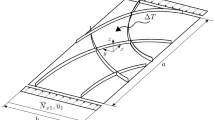Abstract
An analytical investigation is conducted to predict the post-buckling strength of laminated composite stiffened panels under compressive loads. When a stiffened composite panel buckles, the skin would deform into a sinusoidal mode shape, and hence induces additional moments and forces near the skin-stiffener interface region. These induced loads would cause the existing small edge delamination cracks to propagate along the skin-stiffener interface, and this in turn would lead to the global failure of the stiffened panel. To reduce the cost of the analytical investigation, the failure of the stiffened panel under post-buckling loads is modeled in two stages: a global analysis to model the post-buckling behavior of the stiffened panel; and a local analysis to model the onset of propagation of the edge delamination crack at the skin-stiffener interface. The results from this study are compared with an experimental investigation conducted by Starnes, Knight, and Rouse (1987). It is found that for the eight different specimens that are considered in this study, the calculated critical energy release rate for the propagation of the edge delamination crack in each specimen differs substantially from those for the others; hence it may be concluded that the total energy release rate would not be a suitable fracture parameter for predicting the post-buckling strength of the stiffened panels. On the other hand, using the fracture criterion based on the critical mixed-mode stress intensity factors, the predicted post-buckling strength of the stiffened panels compares quite favorably with the experimental results and the standard deviation of the error of prediction is less than 10%. Furthermore, by applying the criterion of critical mixed-mode stress intensity factors on a simple damage model, the present analysis is able to predict the significant reduction in the post-buckling strenght of stiffened panels with a damage due to a low-speed impact at the skin-stiffener interface region.
Similar content being viewed by others
References
Chow, W. T.; Atluri, S. N. 1995: Finite element calculation of stress intensity factors for interfacial crack using virtual closure integral. Computational Mechanics, 16: 417–425
Chow, W. T.; Atluri, S. N. 1996: Stress intensity factors as the fracture parameters for delamination crack growth in thick composite laminates. Submitted to Composites Engg.
Chow, W. T.; Beom, H. G.; Atluri, S. N. 1995: Calculation of stress intensity factors for an interfacial crack between dissimilar anisotropic media, using a hybrid element method and the mutual integral. Computational Mechanics, 15: 546–557
Donaldson, S. L.; Mall, S. 1989: Delamination growth in graphite/epoxy composites subjected to cyclic model III loading. J. Reinforced Plastic and Composites 8: 91–103
Lucas, J. P. 1992: Delamination fracture: Effect of fiber orientation on fracture of a continuous fiber composite laminate. Engg. Frac. Mech., 42: 543–561
O'Brien, T. K. 1982: Characterization of delamination onset and growth in composite laminate. Damage in Composite Materials, ASTM STP 775, pp. 140–167
Qu, J.; Bassani, J. L. 1993: Interfacial fracture mechanics for anisotropic bimaterials. J. Appl. Mech., 60: 422–431
Qu, J.; Li, Q. 1991: Interfacial dislocation and its application to interface cracks in anisotropic bimaterials. J. Elasticity, 26: 169–195
Raju, I. S.; Crews, J. H.Jr.; Aminpour, M. A. 1988: Convergence of strain energy release rate components for edge-delaminated composite laminates. Engg. Frac. Mech. 30: 383–396
Ramkumar, R. L.; Whitcomb, J. D.: Characterization of mode I and mixed-mode delamination growth in T300/5208 graphite epoxy. Delamination and Debonding of Materials, ASTM STP 876 985: 315–335
Rice, J. R. 1988: Elastic fracture mechanics concepts for interfacial cracks. J. Appl. Mech., 55: 98–103
Rice, J. R.; Sih, G. C. 1965: Plane problems of cracks in dissimilar media. J. Appl. Mech. 32: 403–410
Starnes, J. H.Jr.; Knight, N. F.Jr.; Marshall 1985: Postbuckling behavior of selected flat stiffened graphite-epoxy panels loaded in compression. IAAA Journal, 23: 1236–1246
Sun, C. T.; Jih, C. J. 1987: On strain energy release rate for interfacial cracks in bimaterial media. Engg. Fracture Mech., 28: 13–20
Suo, Z.; Hutchinson, J. W. 1990: Interface crack between two elastic layers. Int. J. of Fracture, 43: 1–18
TELAC, MIT: Experimental result for T300-5208 unidirectional laminates.
Wilkins, D. J.; Eisenmann, J. R.; Camin, R. A.; Margolis, W. S.; Benson, R. A. 1982: Characterizing delamination growth in graphite-epoxy. Damage in Composite Materials: Basic Mechanisms, Accumulation, Tolerance, and Characterization, ASTM STP 775: 168–183
Williams, M. L. 1959: The stresses around a fault or crack in dissimilar media. Bull. Seismol. Soc. America, 49: 199–204
Wu, K. C. 1989: Representations of stress intensity factors by path-independent integrals. J. Appl. Mech., 56: 780–785
Author information
Authors and Affiliations
Additional information
Communicated by S. N. Atluri, 22 December 1995
This work is supported by ONR, with Dr. Y. Rajapakse as the program official.
Rights and permissions
About this article
Cite this article
Chow, W.T., Atluri, S.N. Prediction of post-buckling strength of stiffened laminated composite panels based on the criterion of mixed-mode stress intensity factors. Computational Mechanics 18, 215–224 (1996). https://doi.org/10.1007/BF00369939
Issue Date:
DOI: https://doi.org/10.1007/BF00369939




